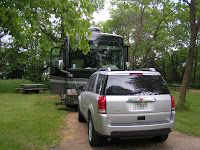
This is the first time we’ve stayed in a state park, and it’s located in the most southwestern corner of Minnesota. It's about 1,500 acres of prairie and grassland, and a small bison herd grazes on a portion of the land. We had electric hookup but not water or sewer, which is fine. We had plenty of water in our fresh water tank, and two days without sewer is no p
roblem. A

s you can imagine, the setting is beautiful and peaceful with only the chirping birds to disturb the stillness. We ventured over to the bison area a few times, but they never were very close to the fence line. With our binoculars we could actually see that they were indeed buffalo and not cows. (Seems the term buffalo and American bison are used interchangeably.)

About 16 miles north of Blue Mounds is the Pipestone National Monument run by the National Park Service. When I think of a monument, I generally think of a granite statue or inscribed boulder, but in this case the Monument is the actual park itself. In 1937 Congress passed an act making the Pipestone quarries an

d the surrounding landscape a National Monument preserving them for the Native American culture. The grounds are still used by Native Americans today for cultural and religious ceremonies.
Pipestone is a reddish stone that is easy to carve and generally is used for pipemaking though other decorative items are also made from it. Legend

is that smoke from these pipes carried messages to the Great Spirit. The stone is generally located about 100 feet below the Sioux Quartzite found in this area, and only Native Americans are allowed to quarry the pipestone. At the visitor center, we viewed a 10 minute film, witnessed a woman actually working on a piece o
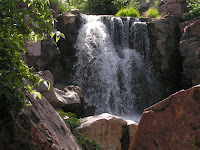
f pipestone, and then took the ¾ mile Circle Trail. Along the trail you see various plants, rock formations, pipestone quarries, and the Winnewissa Falls. No one was working the quarries when we visited but they had one open so you could see the rock. In the picture below right the pipeston
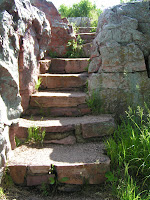
e is the very reddish color located at the bottom 12 inches under the quartzite at floor level.
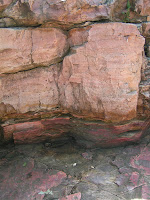
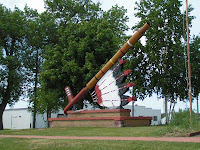
As we drove around town, we passed the Rock Island Railroad Depot and just outside the building sits a giant peace pipe. The county courthouse was built in 1901 and was constructed with local pink Sioux Quartzite stone. Atop the dome is a bronze figure of Lady Justice and in front is a lime

stone statue of a Civil War soldier honoring 201 named veterans of the Civil and Spanish American Wars carved by a local sculptor also in 1901. Also located on the grounds is a World War II Sherman tank purchased in 1962 by the American Legion and VFW to honor the veterans of the 20th-century wars.
We have now added two more states (WI and MN) to those where we have spent the night since beginning our journey almost two years ago. Tomorrow we’ll add another as we continue our trek west and head for the Badlands in South Dakota.

No comments:
Post a Comment